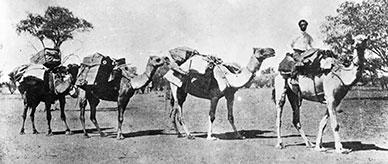


Transcript
[Header in bold capital letters:] COMMONWEALTH OF AUSTRALIA.
[Italics:] Quarantine Act 1908.
[Heading in large bold capital letters:] SEIZURE FORM.
To [blank space captioned 'The person having possession of any goods, animal, or plant subject to Quarantine.' The words 'goods' and 'plant' are underlined.]
[Handwritten in the blank space:] J. B. Moody 28 Silver St., St Peters. [End handwritten]
I HEREBY SEIZE the Goods enumerated and described below, and which I have marked as shown below: -
[Printed table with three columns.]
[Column 1 has the heading 'Kind and Number of Goods.' Handwritten in the space below:] 1 Dog
[Column 2 has the heading 'Description and Brands or Marks.' Handwritten in the space below:] Egyptian Terrier
[Column 3 has the heading 'Seizure Mark.' The space below has been crossed out with a diagonal line.]
[End table.]
[Blank space for date, with the '19' of the year number pre-printed. Handwritten date:] 12.3.45
[Blank space for signature, captioned 'Officer.' Handwritten signature:] SW King.
[Small printed footer:] C.7699.
[Small printed text in left margin:] By Authority: J. KEMP, Government Printer, Melbourne.
About this record
This form, which authorises the seizure of a dog, was issued under the Quarantine Act 1908 of the Commonwealth of Australia. The document was despatched by a quarantine officer of the Commonwealth Department of Health on 12 March 1945 to the dog’s owner JB Moody of the Sydney suburb of St Peters. The form authorises the seizure of an Egyptian terrier which had been illegally brought into Australia. This order was issued with the intention of destroying the animal as a potential disease-carrier.
Educational value
- The document relates to a dog called Horrie, smuggled into Australia in April 1942 by a soldier returning from duty in the Middle East during the Second World War (1939–45). This action contravened strict quarantine standards designed to prevent outbreaks of diseases not present in Australia. In just two months in 1942, quarantine officials inspecting 19 returning troopships found and destroyed 21 dogs, 17 monkeys, 3 squirrels, 1 cat, 1 rabbit, 1 mongoose and 4 birds.
- After being found by Private James 'Jim' Bell Moody as a pup in the Western Desert of Egypt, Horrie took on a symbolic role as the mascot of the 2/1st Machine Gun Battalion of the 2nd Australian Imperial Force. He was appointed an 'honorary corporal' and travelled with the battalion to Greece, Crete, Palestine and Syria. His adventures were later the subject of Horrie the Wog Dog: With the AIF in Egypt, Greece, Crete and Palestine (1948), a book by Ion Llewellyn 'Jack' Idriess (1889–1979).
- Horrie was a survivor, but also an asset to Moody and his comrades with his acute hearing and ability to run messages. In Greece, Horrie's superior hearing was credited with giving Australian soldiers early warning of approaching German warplanes. In Crete, he was used to carry messages in a handkerchief tied to his collar. Horrie also survived a shrapnel injury and the sinking of the ship carrying Moody and his unit to Crete.
- After returning with the battalion by ship to Australia in 1942, Moody smuggled Horrie ashore in Adelaide and left the dog with his father in Melbourne before reclaiming him upon discharge from the army almost three years later. In 1945 just as Idriess's book was about to be published, the authorities learned of Horrie's existence. Moody appealed for him to be spared on the grounds that he had been checked by a vet in Tel Aviv and never shown signs of disease, but his appeal was rejected.
- With this seizure form, Moody was ordered to hand Horrie over, causing a public outcry after reports of his destruction on 12 March 1945. For years, a wreath was laid at the Sydney Cenotaph on Anzac Day in Horrie's memory. But decades later, it was revealed that Moody had handed over a dog that resembled Horrie which he had bought from a pound. The real Horrie lived out his natural life in north-eastern Victoria, reportedly siring many pups.
- The Australian War Memorial in Canberra now holds the specially ventilated kitbag used by Moody to smuggle Horrie into Australia. Made of khaki cotton webbing, it has been modified by the insertion of sections of a wooden packing crate to make space for Horrie. A large slit cut in the back had been 'repaired' with loose weaving, allowing air to reach him. The War Memorial also has a 'uniform' made for Horrie, designed to keep him warm on cold nights in the deserts of the Middle East.
Acknowledgments
Learning resource text © Education Services Australia Limited and the National Archives of Australia 2010.
Related records
Related themes
Need help with your research?
Learn how to interpret primary sources, use our collection and more.





